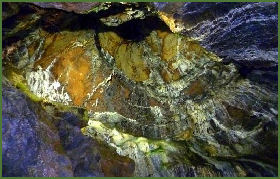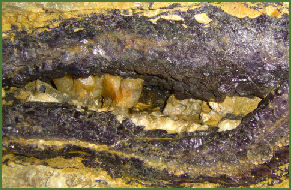Blue John Cavern
OS Grid Ref:-
 The Blue John Cavern is one of the four show caves in the Peak District village of Castleton, which are considered to be the finest range in Great Britain. The cavern is located at the top of the hill above spectacular limestone gorge of Winnats Pass.
The Blue John Cavern is one of the four show caves in the Peak District village of Castleton, which are considered to be the finest range in Great Britain. The cavern is located at the top of the hill above spectacular limestone gorge of Winnats Pass.
The cavern derives its name from the semi-precious mineral Blue John, which is still mined there in small amounts outside the tourist season. The cavern is part natural, part mine-workings, and contains veins of Blue John, fossils, stalactites and stalagmites.The eight working seams are known as Twelve Vein, Old Dining Room, Bull Beef, New Dining Room, Five Vein, Organ Room, New Cavern and Landscape. Old mining equipment is also on view inside the cavern.
The Cavern Tours take the visitor through a number of interconnected natural water-worn caverns such as the Grand Crystallized Cavern with its multi-coloured dome and the Variegated Cavern which is approximately 200 feet high and 30 feet wide. The are of educational interest showing clearly how the caverns are formed in limestone strata and how the limestone itself had much earlier been formed by the deposits on the floors of great oceans which have long since receded, as the fossilised remains of marine animals now show.
Blue John
 Blue John is a semi-precious mineral, a form of fluorite with bands of a purple-blue or yellowish colour. The name derives from the French bleu-jaune, which translates as 'blue-yellow'. In Britain it is only found beneath the hill known as Treak Cliff, just outside of of Castleton. Elsewhere, blue fluorspar is found in the Ardennes region of Belgium; the Cave-in-Rock area of Illinois in the USA and at various localities in Mexico and China.
Blue John is a semi-precious mineral, a form of fluorite with bands of a purple-blue or yellowish colour. The name derives from the French bleu-jaune, which translates as 'blue-yellow'. In Britain it is only found beneath the hill known as Treak Cliff, just outside of of Castleton. Elsewhere, blue fluorspar is found in the Ardennes region of Belgium; the Cave-in-Rock area of Illinois in the USA and at various localities in Mexico and China.
Blue John is Britain's rarest mineral, chemically, it is calcium fluoride (CaF2) which has been coloured by films of oil deposited on the crystals millions of years ago. It is typically found in veins about 3 inches thick in a variety of patterns and shades of purple and blue and has been worked since about 1750.
The earliest recorded reference to Blue John occurs in a letter which bears the date 1766 noting a lease from Lady Mazarine, which states "Lady Mazarine let ye Blue John, Castleton". A later reference is recorded in a 1768 letter by the industrialist Matthew Boulton who attempted to purchase or lease the mines so that he could mine the Blue John to create decorative vases, clearly, by this date the mining of Blue John had been carried out for several years.
